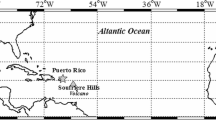Summary
Atmospheric samples have been analyzed for iodine, bromine, and chlorine by neutron activation analysis. Aerosols of marine origin, derived from sea spray, are found to contain the halogens in relative proportions different from sea water, and data from Hawaii and winter northern Alaska indicate fractionation of the elements both during transfer across the sea-air interface and by chemical reactions in the atmosphere. The ratio Br/Cl is usually severalfold greater in aerosols over land than in sea water (Br/Cl=0.0034), but over open sea water it is less. In general, the ratio I/Br exhibits a greater degree of constancy (values cluster in the region I/Br ∼ 0.1–0.2) than does either I/Cl or Br/Cl, suggesting a long residence time and a coherence of I and Br in their movement as particulate material in the atmosphere. However, a singularly effective sea-air transfer mechanism for iodine is indicated by its generally high atmospheric concentration compared to sea water (I/Br=0.001). Bromine of pollution origin and associated with lead has been observed in aerosols from Cambridge, Massachusetts. Chlorine and iodine concentrations are similar to the Hawaii values and provide a basis for resolving excess pollution bromine from the natural marine component. The ratio (excess Br)/Pb in aerosols appears to be correlated directly with the haziness of the air.
Similar content being viewed by others
References
Duce, R. A., J. T. Wasson, J. W. Winchester, andF. Burns: J. Geophys. Research68, 3943–3947 (1963 (Paper I).
Duce, R. A., andJ. W. Winchester: Radiochim. Acta4, 100–104 (1965).
Duce, R. A., J. W. Winchester, andT. W. van Nahl: J. Geophys. Research70, 1775–1799 (1965) (Paper II)
Duce, R. A., J. W. Winchester andT. W. van Nahl: Tellus, in press (1966) (Paper IV).
Junge, C.: Air Chemistry and Radioactivity. New York: Academic Press 1963.
Lininger, R. L., R. A. Duce, J. W. Winchester, andW. R. Matson: J. Geophys. Research71, 2457–2463 (1966) (Paper III).
Matson, W. R., D. K. Roe, andD. E. Carritt: Anal. Chem.37, 1594 (1965).
Winchester, J. W., andR. A. Duce: Tellus, in press (1966) (Paper V).
Author information
Authors and Affiliations
Rights and permissions
About this article
Cite this article
Winchester, J.W., Duce, R.A. The global distribution of iodine, bromine, and chlorine in marine aerosols. Naturwissenschaften 54, 110–113 (1967). https://doi.org/10.1007/BF00640572
Received:
Issue Date:
DOI: https://doi.org/10.1007/BF00640572




